2016 October Cisco Official New Released 300-209 Dumps in Lead2pass.com!
100% Free Download! 100% Pass Guaranteed!
Lead2pass is constantly updating 300-209 exam dumps. We will provide our customers with the latest and the most accurate exam questions and answers that cover a comprehensive knowledge point, which will help you easily prepare for 300-209 exam and successfully pass your exam. You just need to spend 20-30 hours on studying the exam dumps.
Following questions and answers are all new published by Cisco Official Exam Center: http://www.lead2pass.com/300-209.html
QUESTION 101
Which command clears all crypto configuration from a Cisco Adaptive Security Appliance?
A. clear configure crypto
B. clear configure crypto ipsec
C. clear crypto map
D. clear crypto ikev2 sa
Answer: A
QUESTION 102
Which Cisco adaptive security appliance command can be used to view the IPsec PSK of a tunnel group in cleartext?
A. more system:running-config
B. show running-config crypto
C. show running-config tunnel-group
D. show running-config tunnel-group-map
E. clear config tunnel-group
F. show ipsec policy
Answer: A
QUESTION 103
An administrator desires that when work laptops are not connected to the corporate network, they should automatically initiate an AnyConnect VPN tunnel back to headquarters. Where does the administrator configure this?
A. Via the svc trusted-network command under the group-policy sub-configuration mode on the ASA
B. Under the “Automatic VPN Policy” section inside the Anyconnect Profile Editor within ASDM
C. Under the TNDPolicy XML section within the Local Preferences file on the client computer
D. Via the svc trusted-network command under the global webvpn sub-configuration mode on the ASA
Answer: B
QUESTION 104
The following configuration steps have been completed:
– WebVPN was enabled on the ASA outside interface.
– SSL VPN client software was loaded to the ASA.
– A DHCP scope was configured and applied to a WebVPN Tunnel Group.
What additional step is required if the client software fails to load when connecting to the ASA SSL page?
A. The SSL client must be loaded to the client by an ASA administrator
B. The SSL client must be downloaded to the client via FTP
C. The SSL VPN client must be enabled on the ASA after loading
D. The SSL client must be enabled on the client machine before loading
Answer: A
QUESTION 105
Remote users want to access internal servers behind an ASA using Microsoft terminal services. Which option outlines the steps required to allow users access via the ASA clientless VPN portal?
A. 1. Configure a static pat rule for TCP port 3389
2. Configure an inbound access-list to allow traffic from remote users to the servers
3. Assign this access-list rule to the group policy
B. 1. Configure a bookmark of the type http:// server-IP :3389
2. Enable Smart tunnel on this bookmark
3. Assign the bookmark to the desired group policy
C. 1. Configure a Smart Tunnel application list
2. Add the rdp.exe process to this list
3. Assign the Smart Tunnel application list to the desired group policy
D. 1. Upload an RDP plugin to the ASA
2. Configure a bookmark of the type rdp:// server-IP
3. Assign the bookmark list to the desired group policy
Answer: D
QUESTION 106
A custom desktop application needs to access an internal server. An administrator is tasked with configuring the company’s SSL VPN gateway to allow remote users to work. Which two technologies would accommodate the company’s requirement? (Choose two).
A. AnyConnect client
B. Smart Tunnels
C. Email Proxy
D. Content Rewriter
E. Portal Customizations
Answer: AB
QUESTION 107
Refer to the exhibit. Which authentication method was used by the remote peer to prove its identity? 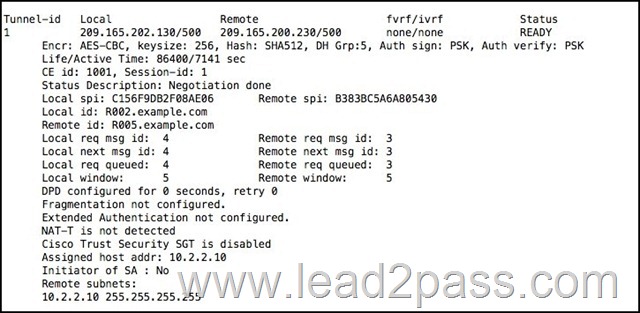
A. Extensible Authentication Protocol
B. certificate authentication
C. pre-shared key
D. XAUTH
Answer: C
QUESTION 108
Refer to the exhibit. An IPsec peer is exchanging routes using IKEv2, but the routes are not installed in the RIB. Which configuration error is causing the failure? 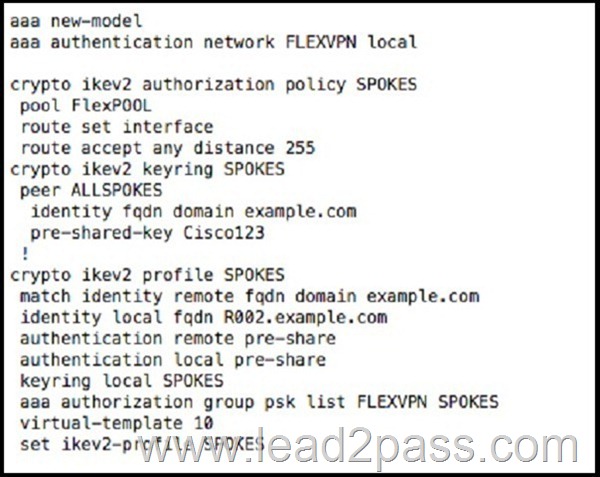
A. IKEv2 routing requires certificate authentication, not pre-shared keys.
B. An invalid administrative distance value was configured.
C. The match identity command must refer to an access list of routes.
D. The IKEv2 authorization policy is not referenced in the IKEv2 profile.
Answer: B
QUESTION 109
Refer to the exhibit. An administrator is adding IPv6 addressing to an already functioning tunnel. The administrator is unable to ping 2001:DB8:100::2 but can ping 209.165.200.226. Which configuration needs to be added or changed? 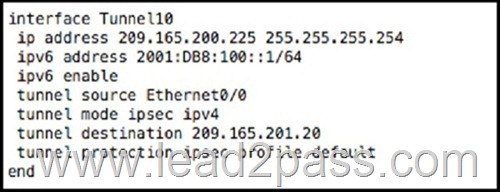
A. No configuration change is necessary. Everything is working correctly.
B. OSPFv3 needs to be configured on the interface.
C. NHRP needs to be configured to provide NBMA mapping.
D. Tunnel mode needs to be changed to GRE IPv4.
E. Tunnel mode needs to be changed to GRE IPv6.
Answer: D
QUESTION 110
Refer to the exhibit. The IKEv2 tunnel between Router1 and Router2 is failing during session establishment. Which action will allow the session to establish correctly? 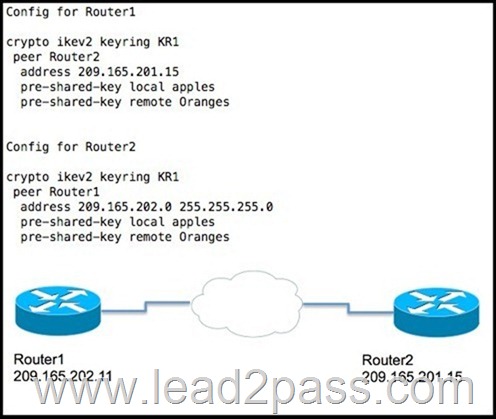
A. The address command on Router2 must be narrowed down to a /32 mask.
B. The local and remote keys on Router2 must be switched.
C. The pre-shared key must be altered to use only lowercase letters.
D. The local and remote keys on Router2 must be the same.
Answer: B
QUESTION 111
A rogue static route is installed in the routing table of a Cisco FlexVPN and is causing traffic to be blackholed. Which command should be used to identify the peer from which that route originated?
A. show crypto ikev2 sa detail
B. show crypto route
C. show crypto ikev2 client flexvpn
D. show ip route eigrp
E. show crypto isakmp sa detail
Answer: A
QUESTION 112
You are troubleshooting a site-to-site VPN issue where the tunnel is not establishing. After issuing the debug crypto isakmp command on the headend router, you see the following output. What does this output suggest?
1d00h: ISAKMP (0:1): atts are not acceptable. Next payload is 0
1d00h: ISAKMP (0:1); no offers accepted!
1d00h: ISAKMP (0:1): SA not acceptable!
1d00h: %CRYPTO-6-IKMP_MODE_FAILURE.
Processing of Main Mode failed with peer at 10.10.10.10
A. Phase 1 policy does not match on both sides.
B. The transform set does not match on both sides.
C. ISAKMP is not enabled on the remote peer.
D. There is a mismatch in the ACL that identifies interesting traffic.
Answer: A
QUESTION 113
You are troubleshooting a site-to-site VPN issue where the tunnel is not establishing. After issuing the debug crypto ipsec command on the headend router, you see the following output. What does this output suggest?
1d00h: IPSec (validate_proposal): transform proposal
(port 3, trans 2, hmac_alg 2) not supported
1d00h: ISAKMP (0:2) : atts not acceptable. Next payload is 0
1d00h: ISAKMP (0:2) SA not acceptable
A. Phase 1 policy does not match on both sides.
B. The Phase 2 transform set does not match on both sides.
C. ISAKMP is not enabled on the remote peer.
D. The crypto map is not applied on the remote peer.
E. The Phase 1 transform set does not match on both sides.
Answer: B
QUESTION 114
Which adaptive security appliance command can be used to see a generic framework of the
requirements for configuring a VPN tunnel between an adaptive security appliance and a Cisco IOS router at a remote office?
A. vpnsetup site-to-site steps
B. show running-config crypto
C. show vpn-sessiondb l2l
D. vpnsetup ssl-remote-access steps
Answer: A
QUESTION 115
After completing a site-to-site VPN setup between two routers, application performance over the tunnel is slow. You issue the show crypto ipsec sa command and see the following output. What does this output suggest?
interfacE. Tunnel100
Crypto map tag: Tunnel100-head-0, local addr 10.10.10.10
protected vrF. (none)
local ident (addr/mask/prot/port): (10.10.10.10/255.255.255.255/47/0)
remote ident (addr/mask/prot/port): (10.20.20.20/255.255.255.255/47/0)
current_peer 209.165.200.230 port 500
PERMIT, flags={origin_is_acl,}
#pkts encaps: 34836, #pkts encrypt: 34836, #pkts digest: 34836
#pkts decaps: 26922, #pkts decrypt: 19211, #pkts verify: 19211
#pkts compresseD. 0, #pkts decompresseD. 0
#pkts not compresseD. 0, #pkts compr. faileD. 0
#pkts not decompresseD. 0, #pkts decompress faileD. 0
#send errors 0, #recv errors 0
A. The VPN has established and is functioning normally.
B. There is an asymmetric routing issue.
C. The remote peer is not receiving encrypted traffic.
D. The remote peer is not able to decrypt traffic.
E. Packet corruption is occurring on the path between the two peers.
Answer: E
QUESTION 116
Refer to the exhibit. An administrator had the above configuration working with SSL protocol, but as soon as the administrator specified IPsec as the primary protocol, the Cisco AnyConnect client was not able to connect. What is the problem? 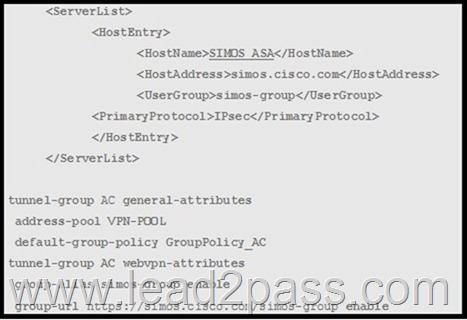
A. IPsec will not work in conjunction with a group URL.
B. The Cisco AnyConnect implementation does not allow the two group URLs to be the same.
SSL does allow this.
C. If you specify the primary protocol as IPsec, the User Group must be the exact name of the
connection profile (tunnel group).
D. A new XML profile should be created instead of modifying the existing profile, so that the clients
force the update.
Answer: C
QUESTION 117
The Cisco AnyConnect client fails to connect via IKEv2 but works with SSL. The following error message is displayed:
“Login Denied, unauthorized connection mechanism, contact your administrator”
What is the most possible cause of this problem?
A. DAP is terminating the connection because IKEv2 is the protocol that is being used.
B. The client endpoint does not have the correct user profile to initiate an IKEv2 connection.
C. The AAA server that is being used does not authorize IKEv2 as the connection mechanism.
D. The administrator is restricting access to this specific user.
E. The IKEv2 protocol is not enabled in the group policy of the VPN headend.
Answer: E
QUESTION 118
The Cisco AnyConnect client is unable to download an updated user profile from the ASA headend using IKEv2. What is the most likely cause of this problem?
A. User profile updates are not allowed with IKEv2.
B. IKEv2 is not enabled on the group policy.
C. A new profile must be created so that the adaptive security appliance can push it to the client on the
next connection attempt.
D. Client Services is not enabled on the adaptive security appliance.
Answer: D
QUESTION 119
Refer to the exhibit. The network administrator is adding a new spoke, but the tunnel is not passing traffic. What could cause this issue? 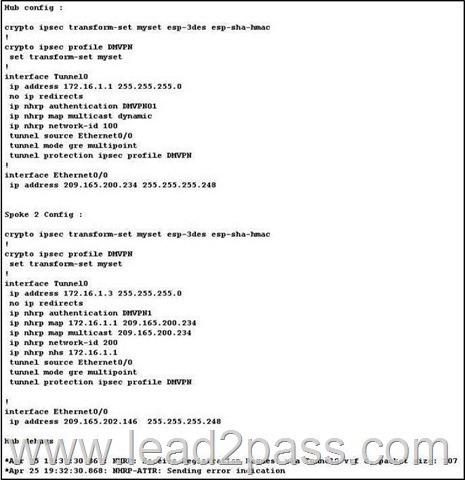
A. DMVPN is a point-to-point tunnel, so there can be only one spoke.
B. There is no EIGRP configuration, and therefore the second tunnel is not working.
C. The NHRP authentication is failing.
D. The transform set must be in transport mode, which is a requirement for DMVPN.
E. The NHRP network ID is incorrect.
Answer: C
QUESTION 120
Which two troubleshooting steps should be taken when Cisco AnyConnect cannot establish an IKEv2 connection, while SSL works fine? (Choose two.)
A. Verify that the primary protocol on the client machine is set to IPsec.
B. Verify that AnyConnect is enabled on the correct interface.
C. Verify that the IKEv2 protocol is enabled on the group policy.
D. Verify that ASDM and AnyConnect are not using the same port.
E. Verify that SSL and IKEv2 certificates are not referencing the same trustpoint.
Answer: AC
Lead2pass is no doubt your best choice. Using the Cisco 300-209 exam dumps can let you improve the efficiency of your studying so that it can help you save much more time.
300-209 new questions on Google Drive: https://drive.google.com/open?id=0B3Syig5i8gpDODI1TDlUT1lBV00
2016 Cisco 300-209 exam dumps (All 237 Q&As) from Lead2pass:
http://www.lead2pass.com/300-209.html [100% Exam Pass Guaranteed]